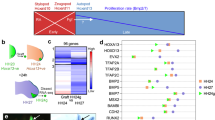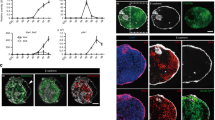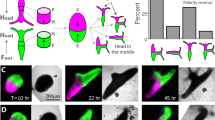Abstract
The polarizing region, a small group of cells at the posterior margin of the limb bud, acts as a signalling region to specify the pattern of structures which develop across the anteroposterior axis of the limb1. When a polarizing region is grafted to the anterior margin of a second limb, a mirror-image symmetrical limb develops1,2. There is indirect evidence that the signal from the polarizing region is a diffusible morphogen3. In an attempt to identify the nature of the putative morphogen, we have developed a method whereby extracts of polarizing region cells and chemicals can be locally applied to the wing bud by being bound to implanted beads and other inert carriers. The chemicals tested included hyaluronidase, dibutyryl cyclic AMP and thalidomide. All experiments have been negative until, at the suggestion of Dr J. Pitts, we tested retinoic acid because of its effects on cell to cell communication and cell differentiation, and we have now for the first tune been able to mimic the action of the polarizing region with a defined chemical.
This is a preview of subscription content, access via your institution
Access options
Subscribe to this journal
Receive 51 print issues and online access
$199.00 per year
only $3.90 per issue
Buy this article
- Purchase on Springer Link
- Instant access to full article PDF
Prices may be subject to local taxes which are calculated during checkout
Similar content being viewed by others
References
Tickle, C., Summerbell, D. & Wolpert, L. Nature 254, 199–202 (1975).
Saunders, J. W. & Gasseling, M. T. in Epithelial-Mesenchymal Interactions (eds Fleishmajer, R. & Billingham, R. E.) 78–97 (Williams & Wilkins, Baltimore, 1968).
Tickle, C. in Development in Mammals Vol. 4 (ed. Johnson, M. H.) 101–137 (North-Holland, Amsterdam, 1980).
Smith, J. C., Tickle, C. & Wolpert, L. Nature 272, 612–613 (1978).
Tickle, C. Nature 289, 295–298 (1981).
Smith, J. C. & Wolpert, L. J. Embryol. exp. Morph. 63, 127–144 (1981).
Strickland, S. & Mahdavi, V. Cell 15, 393–403 (1978).
Pitts, J. D., Burk, R. R. & Murphy, J. P. Cell Biol. int. Rep. Suppl., A5, 45 (1981).
Lotan, R. Biochim. biophys. Acta 605, 33–93 (1980).
Kochhar, D. M. Teratology 7, 289–298 (1973).
Honig, L. S., Smith, J. C., Hornbruch, A. & Wolpert, L. J. Embryol. exp. Morph. 62, 203–216 (1981).
Saxen, L. & Toivonen, S. Primary Embryonic Induction, 1–271 (Logos, London, 1962).
Author information
Authors and Affiliations
Rights and permissions
About this article
Cite this article
Tickle, C., Alberts, B., Wolpert, L. et al. Local application of retinoic acid to the limb bond mimics the action of the polarizing region. Nature 296, 564–566 (1982). https://doi.org/10.1038/296564a0
Received:
Accepted:
Published:
Issue Date:
DOI: https://doi.org/10.1038/296564a0
This article is cited by
Comments
By submitting a comment you agree to abide by our Terms and Community Guidelines. If you find something abusive or that does not comply with our terms or guidelines please flag it as inappropriate.



